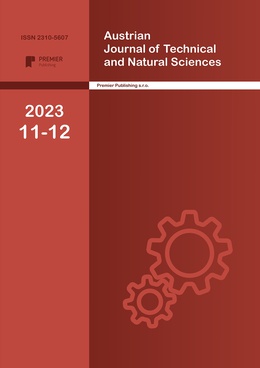Biosorbent based on rice husk for removing copper and nickel ions from wastewater
Authors
Maksudova Aziza Abdukakharovna, Mutalov Shukhrat Akhmadzhonovich, Adilova Klara Muratdjanovna

Share
Annotation
. The adsorption of Cu (II) and Ni (II) ions from aqueous solutions by an adsorbent obtained by treating rice husks with an aqueous solution of monoethanolamine was studied . The structure of the adsorbent was studied using IR spectroscopy. It has been shown that adsorption reaches equilibrium within 60 minutes at an optimal pH value of 5-6. The adsorption process was found to correspond to the Freundlich model with high correlation coefficients. The resulting adsorbent can be used as an effective, inexpensive and environmentally friendly bioadsorbent for treating wastewater from heavy metal ions.
Keywords
Authors
Maksudova Aziza Abdukakharovna, Mutalov Shukhrat Akhmadzhonovich, Adilova Klara Muratdjanovna

Share
References:
1. Acharya J., Kumar U., & Rafi P. M. (2018). Removal of Heavy Metal Ions from Wastewater by Chemically Modified Agricultural Waste Material as Potential Adsorbent-A Review. International Journal of Current Engineering and Technology, of. https://doi.org/10.14741/ijcet/v.8.3.6
2. Zhang Y., Zheng R., Zhao J., Zhang Y., Wong P. K., & Ma F. (2013). Biosorption of zinc from aqueous solution using chemically treated rice husk. BioMed Research International, 2013. https://doi.org/10.1155/2013/365163
3. Wong K. K., Lee C. K., Low K. S., & Haron M. J. (2003). Removal of Cu and Pb from electroplating wastewater using tartaric acid modified rice husk. Process Biochemistry, 39(4), 437–445. https://doi.org/10.1016/S0032-9592(03)00094-3
4. Shrestha B., Kour J., Homagai P. L., Pokhrel M. R., & Ghimire K. N. (2013). Surface Modification of the Biowaste for Purification of Wastewater Contaminated with Toxic Heavy Metals—Lead and Cadmium. Advances in Chemical Engineering and Science, 03(03). https://doi.org/10.4236/aces.2013.33022
5. Sud D., Mahajan G., & Kaur M. P. (2008). Agricultural waste material as potential adsorbent for sequestering heavy metal ions from aqueous solutions - A review. In Bioresource Technology (Vol. 99, Issue 14). https://doi.org/10.1016/j.biortech.2007.11.064
6 . Maksudova A., Adilova K. (2022). Adsorbent based on rise husks. Patent No. 07247, Ministry of Justice of the Republic of Uzbekistan.
7. Bonilla- Petriciolet A., Mendoza-Castillo D.I., & Reynel -Ávila, H.E. (2017). Adsorption processes for water treatment and purification. In Adsorption Processes for Water Treatment and Purification. https://doi.org/10.1007/978-3-319-58136-1
8 . Langmuir I. (1916). The constitution and fundamental properties of solids and liquids. Part I. Solids. Journal of the American Chemical Society, 38 (eleven). https://doi.org/10.1021/ja02268a002
9 . H. M. F. Freundlich, & Freundlich, H. M. F. (1906). About the adsorption in solution. Z. Phys. Chem., 57 (May).


